Clonewheel organ
.jpg)
"Clonewheel organ" is a jargon term used to refer to an electronic musical instrument that emulates (or "clones") the sound of the electromechanical tonewheel-based organs formerly manufactured by Hammond. The phrase "clonewheel" is a pun on the term used to describe how the original Hammond produces sound: through "tonewheels". The first generation of clonewheel organs used synthesizer voices, which were not able to accurately reproduce the Hammond sound. In the 1990s and 2000s, clonewheel organs began using sampling or digital signal processing techniques, which were much better able to capture the nuances of the vintage Hammond sound.
Clonewheel organs can be either keyboard-based instruments such as the Korg CX-3 or the Roland VK-7; or keyboardless emulation devices, which include MIDI modules, such as the E-MU B-3 module and software-based "virtual synths" (such as the B4 by Native Instruments). To use keyboardless emulation devices, they need to be connected to a MIDI-enabled keyboard.
History
Original electromechanical Hammond
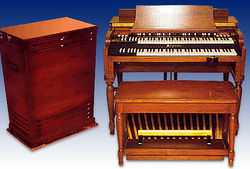


The Hammond organ is an electromechanical organ that was designed and built by Laurens Hammond in 1934. While the Hammond organ was originally sold to churches as a lower-cost alternative to the pipe organ, it came to be used for jazz, blues, and then to a greater extent in rock music (in the 1960s and 1970s) and gospel music.
The original Hammond organ imitated the function of a pipe organ's ranks of pipes in multiple registers by using additive synthesis of waveforms from harmonic series to generate its sounds. The Hammond organ's individual waveforms were made by mechanical tonewheels which rotated beneath electromagnetic pickups. The component waveforms can be mixed in varying ratios by using drawbars mounted above the two keyboards. Hammond organs also have a harmonic percussion effect, in which the 2nd and 3rd harmonic tones can be added to the attack envelope of a note.
Hammond organs have a distinctive percussive key click, which is the attack transient that occurs when all nine key contacts close, causing an audible pop or click. Originally, key click was considered to be a design defect and Hammond worked to eliminate or at least reduce it by using equalization filters. However, some performers liked the percussive effect, and it has become part of the classic sound that modern imitators of the Hammond organ have tried to reproduce. The classic way of enhancing the sound of a Hammond organ is to use a rotating speaker known as a Leslie speaker or cabinet.
First "clones"
.jpg)
Transporting the heavy Hammond organ, bass pedalboard (a B-3 organ, bench and pedalboard weighs 425 pounds/193 kg) and Leslie speaker cabinets to performance venues makes it cumbersome for artists to tour with a vintage electromechanical organ. As well, the Hammond, as with all vintage electromechanical instruments, faces the risk of technical problems with the tonewheels or electric motor, which may be difficult to resolve in a touring situation. As such, there was a strong demand amongst musicians for a way of recreating the Hammond sound in a more portable, reliable fashion.
Some early emulation devices from the 1970s were criticized for their unrealistic imitation of the Hammond sound, particularly in the way the upper harmonics were voiced, and in the simulation of the rotary Leslie speaker effect. Refinements to Hammond emulations eventually led to the development of relatively light electronic keyboard instruments such as the Korg CX-3 (1980), and the Roland VK-1 (1980), which produced fairly realistic re-creations of the Hammond tone. While these instruments were widely used to replace the bulky Hammonds for band tours and club dates, jazz and blues keyboardists still tended to use vintage Hammonds for recordings, because the first clonewheel organs could not reproduce the tonal nuances of the old wooden Hammonds.
1990s and 2000s
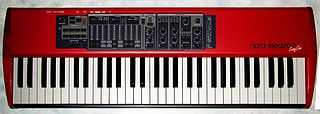
By the 1990s and 2000s digital signal processing and sampling technologies allowed for better imitation of the original Hammond sound, and a variety of electronic organs, emulator devices, and synthesizers provided an accurate reproduction of the Hammond tone, such as the Kurzweil K2600 and Clavia Nord Electro keyboard. Hammond Suzuki USA currently markets numerous home, church, and professional models that digitally reproduce the sound of vintage Hammond tonewheel organs. Some sophisticated emulation devices have algorithms that recreate many of the nuances of vintage Hammonds, such as the "crosstalk" or "leakage" between tonewheels, the sound of dirty key contacts, key click, a growling tube amplifier, and digital simulations of the rotating Leslie speaker cabinet.
Even though the VK-7 recreates the Hammond sound using electronic circuits, the instrument gives a nod to the traditional heritage of the Hammond by using a wooden case.
Currently, there are numerous B-3 "clones" on the market, which range from full-size, dual keyboard behemoths with real Leslie cabinets from Hammond Suzuki (which can cost over $10,000 US), to inexpensive Casio WK series home keyboards that have a digitally-recreated "tonewheel organ" function (which are available for less than $400 US). In between are numerous keyboard-based models from Hammond, Korg, Roland, Clavia (Nord Series), rack-mounted modules, and software-based "virtual synths" (such as the B4 by Native Instruments) which provide simulations of the B-3 sound. There is even a model by the Pari.E company which uses a modern version of the classic Hammond tonewheels, not a digital simulation.
The use of Hammond clones and the merits of using clones versus the vintage electromechanical Hammond is the subject of lively debate amongst musicians. The argument that digital simulations cannot recreate the complex interplay of variables that create the "Hammond sound" (tonewheel leakage, Leslie speaker rotation, etc.) is supported by a review of clones in Keyboard Magazine. The article, entitled "Clonewheel Heaven", reviewed electronic simulations of the traditional Hammond sound, and claimed that some aspects of the vintage electromechanical Hammonds' sound are not accurately reproduced by clones and emulation devices.[1] Nevertheless, the increasing use of clonewheel organs on recordings by jazz and blues organ solo players is testimony to their sound and tone quality; it is also worth noting the wide variety of tonal variations that exist even among genuine vintage tonewheel Hammond organs. Owing to any number of causes — not least of which are the age of its components and the amount of use a tonewheel organ has had — variations in volume levels between tonewheels, varying levels of key click, and other tonal differences are more common than not.
Despite the widespread availability of relatively lower-cost, reliable digital "clones" and emulation devices, and the near-universal use of "clones" for band tours and club gigs, many jazz, blues and gospel keyboardists still have a strong interest in using vintage Hammond organs for studio recordings. Even if a clone is able to copy perfectly the vintage electromechanical Hammond sound — several companies such as Clavia and Hammond Suzuki are already making this claim — performers still have an affection for the look, feel, and quasi-"mystical" sense of musical heritage embodied in the heavy, wooden, vintage instruments.
Instruments
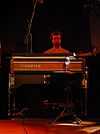
Pre-clonewheel organs
Hammond and related models:
- Ace Tone GT-5, GT-7 (1971, predecessor of Hammond/Sakata models)
- Hammond (manufactured by Sakata) X-5, X-2 (1978),[2] B-200
- Roland VK-9, VK-6, VK-09 (ca.1978, spin off from Ace Tone)
Italian drawbar organs:
- Farfisa Professional, Professional Duo (early '70s) VIP series ('70s), Professional 88 and 110 (1977/78),
- and console models "Maharani" and "Pergamon"
- ELKA X50, X55, X605 and X705
- Crumar Haven, Organizer, Organizer2, Organizer T1, T2, Tokata, portable models from 1976–1980,
- and consoles 203, 204, 205, 2002, 2003
- SOLTON Organ Legend, B1000
etc.
_in_studio.jpg)
Early clonewheel organs
- Hammond B-3000 (1976/1978,[2] utilizing LSI for multiplexing, etc.)[3]
- Korg CX-3, BX-3 (1980, analog)
- Roland VK-1 [4] (1980, analog)
- Hammond (manufactured by Suzuki) Super-B (1986, a first all-digitally sampled organ from Hammond)[5]
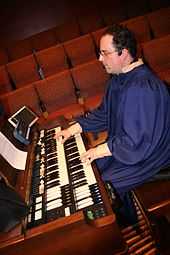
Major clonewheel organs
- Hammond Suzuki XB-1,[6] XB-2 (1991), XB-5 (1993), XB-3 (1994), XC-3 (1995),
- Korg New CX-3 [11] and New BX-3 [12] (2000)
.jpg)
- Clavia Nord Stage, Nord Electro 2, Nord Electro 3, Nord C1 Combo Organ and the new Nord C2 Combo Organ
- Kurzweil K2500, K2600, PC2, PC2X, PC3, PC3X (KB3 mode, modeled tone wheel)
- Roland Rhodes VK-1000, Roland VK-7,[13] VK-77, VK-8,[14] VK-8m, VK-88, and VR-760 (V-Combo)[15]
- Others
- Böhm Emporio
- Casio CTK-691/900/7000/etc, WK-3000/3200/3300/3700/3800/etc - providing digital drawbar organ function.
- Creamware B4000 (Tonewheel synthesizer)
- Diversi Musical Instruments DV-Solo, DV-Duo, DV-Duo Plus
- Ferrofish B4000+
- E-MU B-3 module
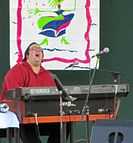
- KeyB/DLQ www.keyborgan.com KeyB Duo, KeyB Solo, KeyB Expander [16]
- Oberheim OB-3,[17] OB-32 (Oh-Bee-Three-Squared, module)[18] and OB-5
- Roland Atelier AT-900, AT-900c, AT-800
- TOKAI TX-5
- Vermona Formation 1, 2, 3 and 3M
- Viscount DB-3,[19] DB-5
- Voce microB-II V3,V5, V5+ and Key5
- Wersi Louvre, Scala, Verona, Giga Piano - a German company.
- Studiologic Numa Organ
- CRUMAR MOJO
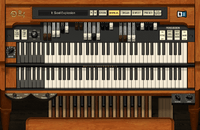
(NI B4 Organ II)
- Software
- There are also software emulations available:
- Native Instruments B4, B4 II
- GSi VB3 (shareware, VST plugin)
- Linplug Organ 3 (previously known as daOrgan)
- Controllers
- BG's Musical Instruments HAMICHORD M-C3[20]
Physical tonewheel clone organs
- PARI.E K-61 - an Italian-made B-3 clone which uses an actual electromagnetic tonewheel generator, albeit of modern plastic construction.[21]
References
- "History & References". Hammond Zone. (officially supported by Hammond U.K.)
- ↑ Stephen Fortner. "Clonewheel Heaven". Keyboard Magazine (November 2004). Retrieved April 28, 2014.
- ↑ 2.0 2.1 "Hammond Accomplishments (1970s)". Hammond Zone.
- ↑ ハモンドオルガンカンパニーがトーンホイールを生産中止した理由 [Why did Hammond Organ Company stop manufacture of the tone wheel organs ?]. ずばり!ハモンド (Frankly on Hammond !) (in Japanese). Hammond Suzuki.
- ↑ Sam Inglis. "Roland VK-1 Drawbar - Organ (Retro)". Reviews. Sound On Sound (January 1999).
- ↑ "Hammond Accomplishments (1980s)". Hammond Zone.
- ↑ Nick Magnus. "Hammond XB-1". Sound On Sound (October 1998).
- ↑ Nick Magnus. "Hammond XM-1 & XMc-1 - Organ Module & Drawbar Controller". Sound On Sound (May 1997).
- ↑ "Hammond XK-3/XLK-3 & Leslie 2121/2101 - Modelled Tonewheel Organ & Rotary Speaker System". Sound On Sound (July 2005).
- ↑ Damien Albetto. "Instrument Review: Hammond SK1". Muse Live Music Magazine.
- ↑ Hugh Robjohns. "Hammond New B3 - Modelled Electromechanical Tonewheel Organ". Reviews. Sound On Sound (July 2003).
- ↑ Gordon Reid. "Korg CX-3 - Modelling Tonewheel Organ". Reviews. Sound On Sound (January 2001).
- ↑ Gordon Reid. "Korg BX-3 Organ - Dual-manual Modelled Combo Organ". Reviews. Sound On Sound (August 2003).
- ↑ Nick Magnus. "Roland VK-7 - Virtual Modelling Tonewheel Organ". Reviews. Sound On Sound (July 1997).
- ↑ Gordon Reid. "Roland VK-8 - Virtual Tonewheel Organ". Reviews. Sound On Sound (September 2002).
- ↑ Hugh Robjohns. "Roland VR760 - Performance Keyboard". Sound On Sound (November 2003).
- ↑ "KeyB Organ". KeyB/DLQ.
- ↑ Andy Davies. "Oberheim Eclipse Electronic Piano & OB3 Drawbar Organ Module". Sound On Sound (March 1996).
- ↑ Nick Magnus. "Oberheim/Viscount OB3-squared - Tonewheel Organ Module". Reviews. Sound On Sound (September 1997).
- ↑ Gordon Reid. "Viscount DB3 - Viscount DB3 Digital Drawbar Organ". Reviews. Sound On Sound (November 2002).
- ↑ "HAMICHORD M-C3 organ MIDI controller". BG's Musical Instruments.
- ↑ "PARI.E electromagnetic organ". BG's Musical Instruments.